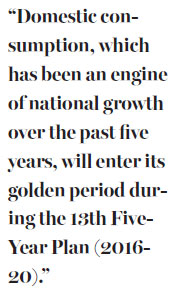Consumption leads economic revival
China will show the way as incomes double in a decade and Chinese become the world's fastest growing consumers
Which country will lead new economic development? The answer is China, because it has the largest population, and is set to become the world's largest economy, largest trader, largest buyer and the largest consumer market.
In the next five years, despite some uncertainties, China has the ability to maintain an annual economic growth of 6.5 to 7 percent. Irrespective of whether it is calculated on the basis of exchange rate or purchasing power parity, the Chinese economy is expected to account for at least 20 percent of the world economy.
Chinese people's incomes are expected to double from the 2010 levels by 2020, when the country's population is projected to reach 1.4 billion. If China can maintain growth between 6.5 percent and 7 percent, its citizens' average annual personal disposable income will increase from 22,000 yuan ($3,385; 2,998 euros) in 2015 to at least 30,000 yuan in 2020. And Chinese people will become the fastest growing consumers in the world.

Domestic consumption, which has been an engine of national growth over the past five years, will enter its golden period during the 13th Five-Year Plan (2016-20). Last year, the total volume of retail sales in China reached 30 trillion yuan ($4.61 trillion), which is expected to double by 2020.
The new growth points and models of consumption appearing in this process can improve China's consumption structure. The Engel Coefficient, the percentage of money spent on food in urban residents' overall consumption, is less than 30 percent, which signifies a healthy livelihood structure. And rural residents' average Engel Coefficient is nearing that level.
In the future, Chinese people will spend more on education, medical care, cultural activities and products, eldercare and tourism, with farmers' consumption increasing by a large margin.
Take tourism, for example. On average, every Chinese citizen traveled 3.2 times within the country last year; the figure is estimated to increase to 4.6 by 2020. This change suggests Chinese consumers' incomes will rise from the medium to high level.
Moreover, China's spending will rely more and more on the Internet. Last year, Chinese consumers spent more than 4 trillion yuan on e-commerce, which accounted for 13.3 percent of the country's total retail sales volume. By 2020, they are expected to spend three to four times more.

Besides, the government is likely to purchase more public services from the market in the next five years, making it a new growth point in consumption. This will help raise the contribution of consumption to China's economic growth to 60 to 70 percent by 2020.
Also, the government attaches great importance to making China a strong power in terms of the Internet, e-commerce and information and communications technologies. If the government's plans are realized, China will become a power in the Internet of Things as well as a global e-commerce market.
The number of Internet users in the United States was 1,750 times that in China in 1995. Today, China has the largest number of Internet users and is one of the most networked countries in the world.
China is in for five big changes: transformation from the "world's factory" to a world market, consumption-led growth replacing investment- and export-driven growth, greater economic reliance on the service sector than industries, shift in decision-makers' focus from the manufacturer-sovereignty model to the consumer-sovereignty model, and overcoming the middle-income trap through innovative technology and governance reform.
And China's booming consumer market will result in obvious spillover effects and benefit consumers across the world. And that will be the new tangible and unique contribution of China to global economic development.
The author is a researcher in economics at Tsinghua University. The views do not necessarily reflect those of China Daily.
(China Daily Africa Weekly 04/01/2016 page13)


















